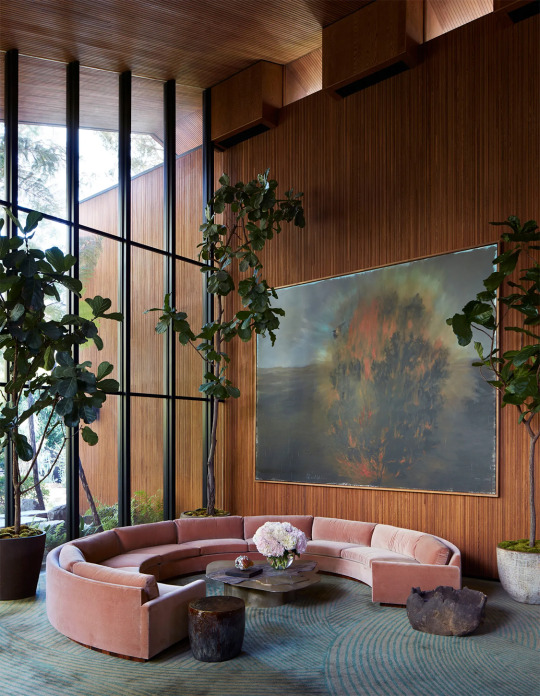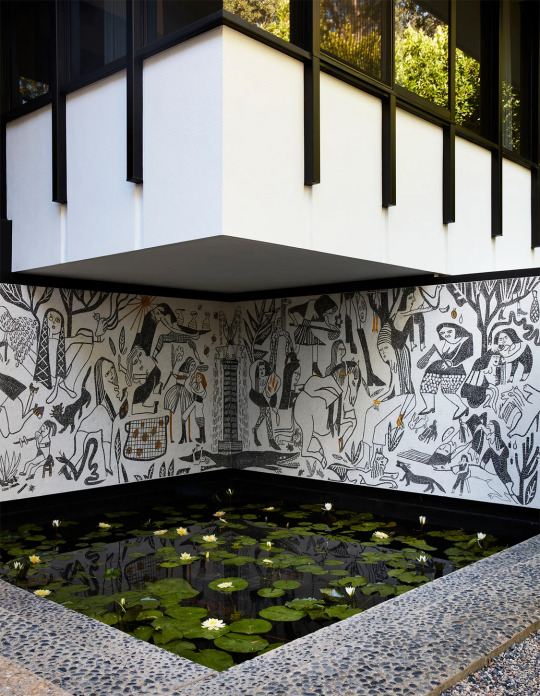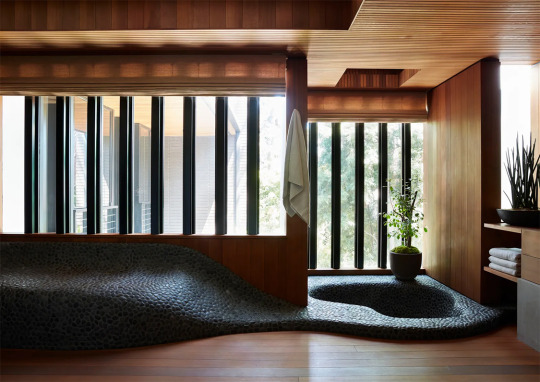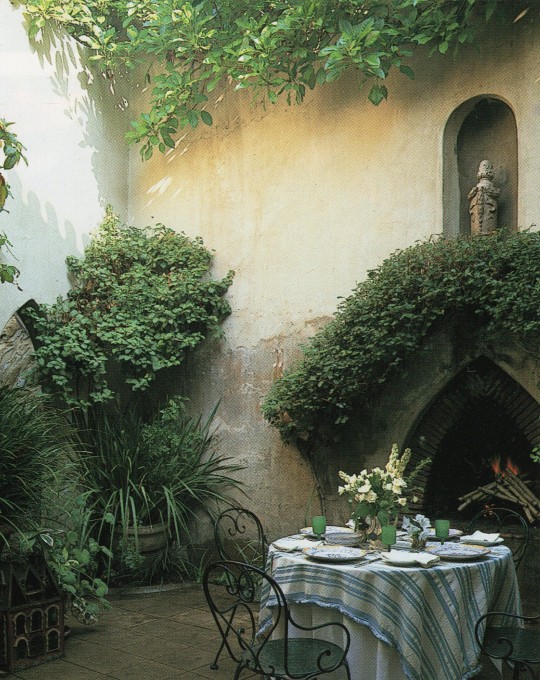#Landscaper in Los Angeles
Explore tagged Tumblr posts
Text
#Landscaper in Los Angeles#Landscape Designer in Los Angeles#Artificial Turf Installation near me#Sod Installation near me#Synthetic Grass Installtion near me
1 note
·
View note
Text
As relentless rains pounded LA, the city’s “sponge” infrastructure helped gather 8.6 billion gallons of water—enough to sustain over 100,000 households for a year.
Earlier this month, the future fell on Los Angeles. A long band of moisture in the sky, known as an atmospheric river, dumped 9 inches of rain on the city over three days—over half of what the city typically gets in a year. It’s the kind of extreme rainfall that’ll get ever more extreme as the planet warms.
The city’s water managers, though, were ready and waiting. Like other urban areas around the world, in recent years LA has been transforming into a “sponge city,” replacing impermeable surfaces, like concrete, with permeable ones, like dirt and plants. It has also built out “spreading grounds,” where water accumulates and soaks into the earth.
With traditional dams and all that newfangled spongy infrastructure, between February 4 and 7 the metropolis captured 8.6 billion gallons of stormwater, enough to provide water to 106,000 households for a year. For the rainy season in total, LA has accumulated 14.7 billion gallons.
Long reliant on snowmelt and river water piped in from afar, LA is on a quest to produce as much water as it can locally. “There's going to be a lot more rain and a lot less snow, which is going to alter the way we capture snowmelt and the aqueduct water,” says Art Castro, manager of watershed management at the Los Angeles Department of Water and Power. “Dams and spreading grounds are the workhorses of local stormwater capture for either flood protection or water supply.”
Centuries of urban-planning dogma dictates using gutters, sewers, and other infrastructure to funnel rainwater out of a metropolis as quickly as possible to prevent flooding. Given the increasingly catastrophic urban flooding seen around the world, though, that clearly isn’t working anymore, so now planners are finding clever ways to capture stormwater, treating it as an asset instead of a liability. “The problem of urban hydrology is caused by a thousand small cuts,” says Michael Kiparsky, director of the Wheeler Water Institute at UC Berkeley. “No one driveway or roof in and of itself causes massive alteration of the hydrologic cycle. But combine millions of them in one area and it does. Maybe we can solve that problem with a thousand Band-Aids.”
Or in this case, sponges. The trick to making a city more absorbent is to add more gardens and other green spaces that allow water to percolate into underlying aquifers—porous subterranean materials that can hold water—which a city can then draw from in times of need. Engineers are also greening up medians and roadside areas to soak up the water that’d normally rush off streets, into sewers, and eventually out to sea...
To exploit all that free water falling from the sky, the LADWP has carved out big patches of brown in the concrete jungle. Stormwater is piped into these spreading grounds and accumulates in dirt basins. That allows it to slowly soak into the underlying aquifer, which acts as a sort of natural underground tank that can hold 28 billion gallons of water.
During a storm, the city is also gathering water in dams, some of which it diverts into the spreading grounds. “After the storm comes by, and it's a bright sunny day, you’ll still see water being released into a channel and diverted into the spreading grounds,” says Castro. That way, water moves from a reservoir where it’s exposed to sunlight and evaporation, into an aquifer where it’s banked safely underground.
On a smaller scale, LADWP has been experimenting with turning parks into mini spreading grounds, diverting stormwater there to soak into subterranean cisterns or chambers. It’s also deploying green spaces along roadways, which have the additional benefit of mitigating flooding in a neighborhood: The less concrete and the more dirt and plants, the more the built environment can soak up stormwater like the actual environment naturally does.
As an added benefit, deploying more of these green spaces, along with urban gardens, improves the mental health of residents. Plants here also “sweat,” cooling the area and beating back the urban heat island effect—the tendency for concrete to absorb solar energy and slowly release it at night. By reducing summer temperatures, you improve the physical health of residents. “The more trees, the more shade, the less heat island effect,” says Castro. “Sometimes when it’s 90 degrees in the middle of summer, it could get up to 110 underneath a bus stop.”
LA’s far from alone in going spongy. Pittsburgh is also deploying more rain gardens, and where they absolutely must have a hard surface—sidewalks, parking lots, etc.—they’re using special concrete bricks that allow water to seep through. And a growing number of municipalities are scrutinizing properties and charging owners fees if they have excessive impermeable surfaces like pavement, thus incentivizing the switch to permeable surfaces like plots of native plants or urban gardens for producing more food locally.
So the old way of stormwater management isn’t just increasingly dangerous and ineffective as the planet warms and storms get more intense—it stands in the way of a more beautiful, less sweltering, more sustainable urban landscape. LA, of all places, is showing the world there’s a better way.
-via Wired, February 19, 2024
#california#los angeles#water#rainfall#extreme weather#rain#atmospheric science#meteorology#infrastructure#green infrastructure#climate change#climate action#climate resilient#climate emergency#urban#urban landscape#flooding#flood warning#natural disasters#environmental news#climate news#good news#hope#solarpunk#hopepunk#ecopunk#sustainability#urban planning#city planning#urbanism
14K notes
·
View notes
Text

The Los Angeles House: Decoration and Design in America's 20th-Century City, 1995
#vintage#vintage interior#1990s#90s#interior design#home decor#entrance#eclectic#quirky#artistic#obelisk#garden#pathway#landscape design#Los Angeles#California#pool#Moroccan#style#home#architecture
3K notes
·
View notes
Text
Was a little nostalgic of the rainy vibes in Burbank. Hoping we get a little sometime. I definitely debated whether or not I wanted the rain to move or not, I'm actually super happy with how this turned out!
#illustration#artists on tumblr#color#painting#gifs#animation#rainyday#rainymood#cozy vibes#cozy#rain#plein air#landscape painting#burbank#los angeles
1K notes
·
View notes
Text


valley girl; studio city, california
instagram - twitter - website
#artists on tumblr#photographers on tumblr#landscape#nature#aesthetic#gif#photoset#original photographers#los angeles#california#plants#moody#weather#cinemagraph#leah berman#cityscape#scenery#blue#art#city#traffic#photography#flowers#pink#pastel
840 notes
·
View notes
Text

#photographers on tumblr#artists on tumblr#landscape#flowers#flowercore#beautiful flowers#aesthetic#garden#california#pastel#nature#plants#scenery#roses#los angeles#paradise#exlore#explore#inspiration#photography#adventure#motivation#travel
2K notes
·
View notes
Text



Los Angeles, USA. 8th January, 2025. Plumes of smoke drift over Santa Monica Beach as the Pacific Palisades fire burns near Los Angeles, California. Photo Credit: Stu Gray
#photography#fires#los angeles#california#santa monica#beach#landscape#nature#palisades#plumes#smoke#sky#sun#orange#stu gray#palm trees#trees#pacific palisades#u
290 notes
·
View notes
Text

A pleinair painting that recently appeared at the Molskine show at Hashimoto Contemporary in San Francisco. Made with gouache in Echo Park, Los Angeles.
#artists on tumblr#kellan jett#art#gouache#sketches#pleinairpainting#plein air#night painting#urban painting#gouache painting#landscape painting#landscape#urban sketch#los angeles#la#echo park
317 notes
·
View notes
Text


Kalbinde iyilik biriktirenlerin yolu daima açıktır. 🕊️
Şems-i Tebrizi
#photographers on tumblr#artists on tumblr#landscape#flowers#flowercore#beautiful flowers#aesthetic#garden#california#pastel#nature#plants#scenery#roses#los angeles#paradise#exlore#explore#inspiration#photography#adventure#motivation#travel
544 notes
·
View notes
Text

Los Angeles through an apartment kitchen window
#mine#fujifeed#fujixseries#landscape photography#california#los angeles#LA#cityscape#skyline#photographers on tumblr#downtown los angeles#photography
337 notes
·
View notes
Text

Brazilian Landscape with a Worker's House, Frans Post, ca. 1655
#art#art history#Frans Post#landscape#landscape painting#landscape art#Brazil#South America#Dutch Golden Age#Baroque#Baroque art#Dutch Baroque#Dutch art#17th century art#oil on panel#Los Angeles County Museum of Art#lacmamuseum#lacma
223 notes
·
View notes
Photo










Smalley House, Holmby Hills, Los Angeles, USA,
Built by A. Quincy Jones in 1973, Updated by Studio Shamshiri,
Landscape architect: Garret Eckbo
#art#design#architecture#interiors#smalley#los angeles#holmby hills#A. quincy jones#luxuryhouses#luxuryhomes#luxurylifestyle#landscaping#garret eckbo#shulamit nazarian#renovation#mid century modern#biomorphism
2K notes
·
View notes
Text

126 notes
·
View notes
Text

The Los Angeles House: Decoration and Design in America's 20th-Century City, 1995
#vintage#vintage interior#1990s#90s#interior design#home decor#patio#stucco#fireplace#garden#landscape design#bistro furniture#back porch#al fresco#classical#traditional#style#home#architecture#Los Angeles#California
3K notes
·
View notes
Text

I always love the view from this hill! It overlooks Los Angeles in a different view and it makes the city shine bright. Whenever I get to the top I always ponder what people are doing and thinking at this moment in time.
#illustration#artists on tumblr#color#painting#plein air#los angeles#landscape painting#photoshop#digital painting#hiking#adventure#sunset#sunny day
154 notes
·
View notes
Text

Photographer John Humble
#photography#john humble#urban landscapes#los angeles#long beach#street photography#new topographics
88 notes
·
View notes